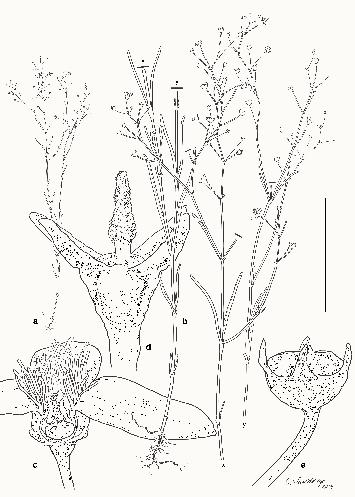
4 minute read
Cutting edge
Grevillea pieroniae
CUTTING EDGE
Advertisement
RESEARCHERS WORKING WITH THE SCIENTISTS AT THE GARDENS PUBLISH MORE THAN 90 PEER REVIEWED ARTICLES EACH YEAR. DR BRETT SUMMERELL HIGHLIGHTS A FEW RECENT RESEARCH PROJECTS.
BREAKING SEED DORMANCY 1 Many species of rainforest trees have seed that is described as dormant. This means the seed, when in conditions that should favour germination, do not do so (or only a relatively small proportion do so).
This is important from an evolutionary perspective as the seed will need to wait until the very best conditions – for example, when a gap is created in the canopy due to storms or a tree death – in order to allow the species to prosper. However, if we are to propagate the tree (in a botanic garden or to restore habitat), we need to know how to overcome this trait.
Dr Ganesha Liyanage, a scientist in our rainforest seed conservation project, has been researching methods to overcome this dormancy in several species of Acronychia (A. imperforata, A. laevis and A. oblongifolia), which are members of the Rutaceae family (the Citrus family).
There are about 20 species of Acronychia in Australian rainforests and as these ecosystems are under threat it is critical to ensure these species are in seed banks and botanic gardens to ensure their future survival.
Four different techniques were tested for their effect on dormancy: (i) incubation of intact seeds on agar incorporating the plant hormone gibberellic acid; (ii) seed coat removal; (iii) scarification (scratching) near the root radicle emergence point; and (iv) scarification opposite the radicle emergence point.
Paranotis halfordii by Catherine Wardrop
Dr Ganesha Liyanage
Scarification was shown to be the best treatment – increasing germination from 6% to around 65%. This is a relatively simple technique that can be used in places like PlantBank but also by community conservation groups hoping to grow this plant for regeneration work.

NEW SPECIES FROM WA 2,3 Our botanists, just like plants, are not restricted to state boundaries, and inevitably when working on the taxonomy of major groups they need to assess species from across the country (and sometimes across the world) to better understand them.
Our Flora Botanist, Dr Kerry Gibbons has been studying Australian species in the Rubiaceae family (the coffee family) and has recently described - in collaboration with Steve Dillon from the Western Australian Herbarium - a new species of Paranotis, Paranotis halfordii, a small herb found in the Kimberley region of Western Australia. Last year, Kerry also described the genus Paranotis.
One of our Honorary Research Associates, Peter Olde, also recently described a new species of Grevillea, Grevillea pieroniae, from the Stirling Ranges in WA. Peter has spent decades studying Grevillea and is an authority of the genus. This species is very rare and is found in areas that have been infested with the root rot pathogen, Phytophthora cinnamomi, so is likely to be of significant conservation concern.
It is critical to describe and document these species – only by identifying and naming them can we properly protect and conserve them.

WHEN TWO BECOME ONE 4 Deciding what defines a species inevitably causes lots of discussion and disagreement amongst taxonomists. In fact, there is a saying in taxonomic circles: ‘get 10 taxonomists together and they will come up with 12 (or more) species concepts’.
The conflict arises because much of the data used is subjective – for example, taxonomists might differ in how much importance they assign to flower colour, leaf shape or other morphological features. This is changing as more use is made of molecular data, which can be analysed statistically, but decisions must still be made as to whether two differentiated groups are species or just populations within a species. Genomic tools, where we document more and more of the genomic information of a species, allow us to amass larger datasets and make the task of differentiating, or not, species more reliable.
Dr Susan Rutherford and co-authors have done this for the genus Angophora, which are a group of 14 species of eucalypts, the best known being the Red Gum, Angophora costata.
They analysed eight of the species in eastern Australia and found some subspecies could not be genetically differentiated. Two species Angophora subvelutiana and Angophora floribunda were also not genetically distinct, and thus could be considered one species.
They also found that distribution and genetic differentiation within Angophora were strongly influenced by temperature and humidity, as well as biogeographic barriers, particularly rivers and higher elevation regions. This latter information will be important in determining the impact of environmental change on these species.
These insights can have a critical impact on the future management of these species because they enable us to focus conservation resources more effectively and efficiently.
PAPERS 1. Seed Science and Technology: doi.org/10.15258/sst.2020.48.2.03. 2. Telopea: dx.doi.org/10.7751/telopea14347. 3. Telopea: dx.doi.org/10.7751/telopea14783. 4. Evolution: doi:10.1111/evo.14140.










